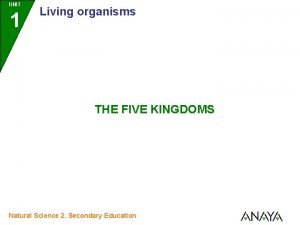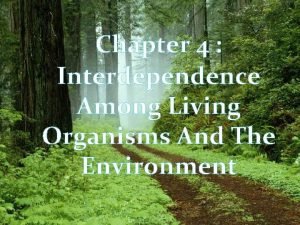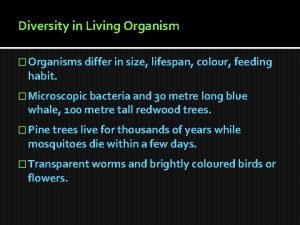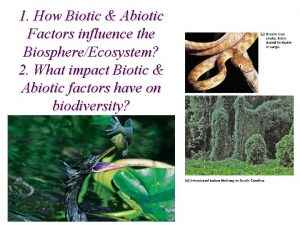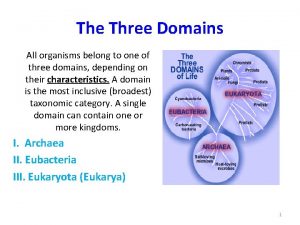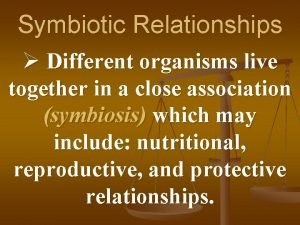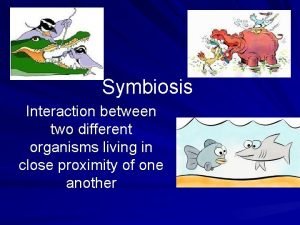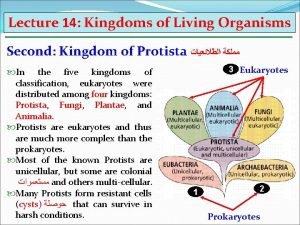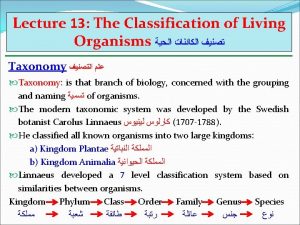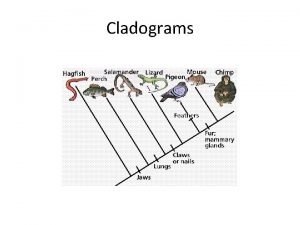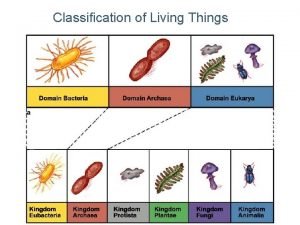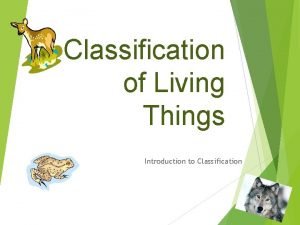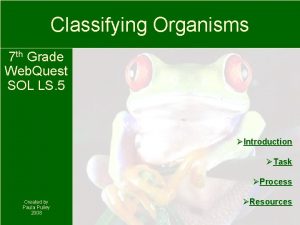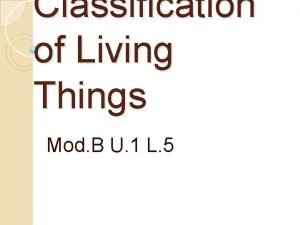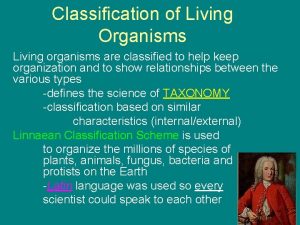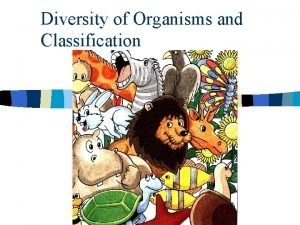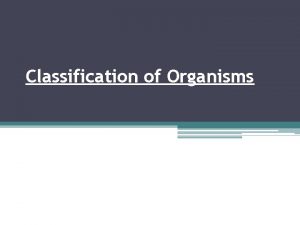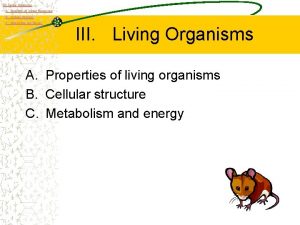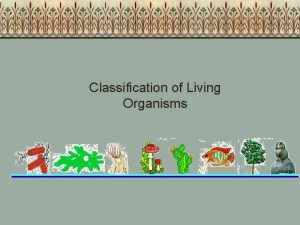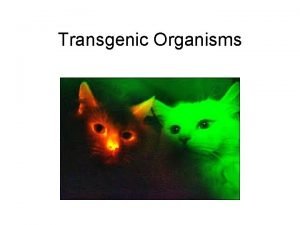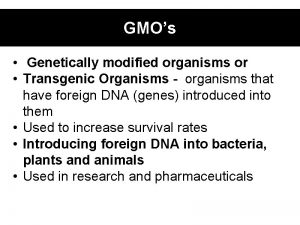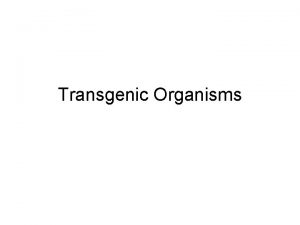The Classification of Living Organisms What does the











































- Slides: 43

The Classification of Living Organisms

What does the word classification mean?

What does the word classification mean? The process of grouping things based on similarities.

How is a mall organized? • • Food Court Big Department Stores Specialty Clothing Stores Jewelry Stores Electronics Stores Shoe Stores Toy Store

What do scientists classify? The elements • The human body Interactions in Ecosystems

Scientists also classify living organisms How could you classify these living things?

Quick, organize these living things into groups:

Did you do it like this?

Or This? Are there any other ways to group these living things?

What does the word taxonomy mean?

What does the word taxonomy mean? The scientific study of how living things are classified.

The most basic classification system is based on Domains and Kingdoms. Organisms are classified into Domains or Kingdoms based on these characteristics: 1. Whether they are prokaryotic or eukaryotic 2. Whether they are unicellular or multicellular 3. Whether they are autotrophic or heterotrophic 4. Whether they reproduce sexually or asexually 5. Whether they have a cell wall 6. How they tolerate heat, salt, or other extreme conditions

1. Whether they are prokaryotic or eukaryotic Prokaryotic – no nucleus Eukaryotic – with nucleus

2. Whether they are unicellular or multicellular Unicellular – one cell Multicellular – more than one cell

3. Whether they are autotrophic or heterotrophic Autotrophic - organisms that make their own food (a self feeder). Heterotrophic - organisms that cannot make their own food (must feed off others)

4. Whether they reproduce sexually or asexually Asexual reproduction is a process that only involves one parent, not two. Sexual reproduction is a process that involves a combination of genetic material from two parents – a male and a female.


The most basic classification system is based on Domains and Kingdoms. Organisms are classified into Domains or Kingdoms based on these characteristics: 5. Whether they have a cell wall Cell Wall surrounds the cell membrane and provides cells with structural support and protection

6. How they tolerate heat, salt, or other extreme conditions

Why do scientists use classification systems for organisms?

Why do scientists use classification systems for organisms? It makes it easier to study them.

Domains Represent the largest differences among organisms. There are 3 domains: Archaea Bacteria Eukaryota

Domains • Archaea • (Kingdom called Archaebacteria) • Bacteria • (Kingdom called Eubacteria) • Eukaryota • (Kingdoms: Protista, Animalia, Plantae, Fungi) Bacteria Eukaryota

Basic Classification Kingdoms: Kingdom is the broadest classification level. The Domains can also be split into Kingdoms, which further divide the organisms by their characteristics

Domains & Kingdoms Archaeabacteria Animalia Plantae Eubacteria Fungi Protista

Basic Classification Domains: Archaea Eubacteria • Archaea means “ancient” bacteria • Bacteria that are adapted to extreme environments Eukaryota

Domain Archaea v Archaea means “ancient” bacteria v Characteristics of organisms: • unicellular • prokaryotic • autotrophic or heterotrophic Aerial view of hot spring at Yellowstone • Asexual reproduction • Bacteria that have adapted to extreme environments • Some can survive in extremely hot environments like around hot springs and geysers (they are called thermophiles) • Some can survive in extremely salty environments like The Great Salt Lake in Utah (they are called halophiles) v The Domain Archaea has one Kingdom, also called Archaeabacteria

This hot spring is flowing into the Firehole River in Yellowstone. The colors are caused by different varieties of archaebacteria and other microscopic life forms. Scientists can distinguish temperatures of water by the colors present.

Basic Classification Domains: Archaea Bacteria Eukaryota • Most abundant organisms on earth • One bacterium can give rise to 10 million in 24 hours

Domain bacteria v Found in almost every habitat on earth v Many are common infectious agent v Characteristics of organisms: unicellular prokaryotic autotrophic or heterotrophic Asexual reproduction Most abundant organisms on earth (one bacterium can give rise to 10 million in 24 hours) v The Domain bacteria has one Kingdom, also called Eubacteria.

This is a picture of bacteria on the skin. Bacteria can be shaped like a sphere (cocci) like this picture, like a rod, or like a spiral. The structure in the middle of this picture is a hair follicle with a hair growing out of it.

Terminology: The Domains Archaea and Bacteria are commonly grouped together and called Prokaryotes because they lack both a membrane bound nucleus and membrane bound organelles Nucleus and Organelles

Basic Classification Domains: • Eukaryota means “True-Nucleus” • All Eukaryota’s have a nucleus • Includes all the organisms that are not bacteria Eubacteria Archaea Eukaryota

Domain Eukaryota (Eukarya) v. Divided into 4 Kingdoms: Protista Fungi Plantae Animalia

Animalia • No cell wall • Heterotrophic • Multicellular • Sexual & asexual • Examples: insects spiders crabs humans birds

Fungi • Decomposers • Can be infectious • Most are Multicellular Few can be Unicellular (yeast) üHeterotrophic üAsexual & Sexual • Examples: mushrooms athlete’s foot bread mold

• Can be infectious agents Protista • Usually Unicellular and microscopic Some algae are Multicellular • autotrophic or heterotrophic • sexual or asexual Reproduction • Examples: amoeba algae Daphnia Plasmodium (causes malaria)

Plantae üMulticellular üAutotrophic through photosynthesis üSexual & Asexual • Examples: mosses ferns trees flowering plants v. Cell Wall v. Chloroplast

The 4 Kingdoms in Eukaryota Protista Plantae Can be infectious agents. unicellular autotrophic or heterotrophic. sexual or asexual Reproduction. Examples: amoeba algae Daphnia Plasmodium (causes malaria) Multicellular green plants Autotrophic through photosynthesis Sexual & Asexual Examples: mosses ferns trees flowering plants Fungi Animalia Decomposers Can be infectious Multicellular Heterotrophic Agents. Asexual & Sexual Examples: mushrooms athlete’s foot bread mold No cell wall Heterotrophic Multicellular Sexual & asexual Examples: insects spiders crabs humans Birds

Archaebacteria D O M A I N S Bacteria K I N G D O M S

How would you classify these? 1. A organism that can exist in extremely hot temperatures. It is made of only one cell and does not have a nucleus. Domain: _____ Kingdom: _____ Archaea 2. A green organism that is growing from the ground. It is multicellular and undergoes photosynthesis. Its cells have a nucleus as well as cell walls. Domain: _____ Kingdom: _____ Eukaryota Plantae

Try two more: 3. This organism is microscopic and one-celled. It lives in colonies where millions of others like it are present. It does not have a nucleus. It cannot survive in extreme conditions. It could be an infectious agent. Domain: ______ Kingdom: _____ Eubacteria 4. This organism is multicellular. It is a decomposer. Its cells have a nucleus as well as cell walls. Domain: ______ Kingdom: _____ Eukaryota Fungi

Classification Systems Can Change! Can you guess why? • Classification systems change as new organisms are discovered and as more information is gained about living organisms • Science is a “work in progress” and things change as new evidence is found
 Venn diagram living and non living
Venn diagram living and non living Modern classification of living organisms
Modern classification of living organisms Member of the same species
Member of the same species Unicellular and multicellular living things
Unicellular and multicellular living things Example of kingdoms
Example of kingdoms What do the rabbit, fungus, and tree have in common? *
What do the rabbit, fungus, and tree have in common? * Different types of living organisms
Different types of living organisms Mynah and buffalo interaction
Mynah and buffalo interaction Planaria, liverfluke, tapeworm, ascaris *
Planaria, liverfluke, tapeworm, ascaris * 5 levels of organisms
5 levels of organisms Two different organisms living together
Two different organisms living together Biology kingdoms
Biology kingdoms What is the smallest unit of living organisms
What is the smallest unit of living organisms Living organisms
Living organisms Remains, imprints or traces of once-living organisms
Remains, imprints or traces of once-living organisms Domain of life
Domain of life Similar
Similar Two different organisms living together
Two different organisms living together Close interaction between two different organisms
Close interaction between two different organisms Small living organisms
Small living organisms Kingdom protists
Kingdom protists What are original remains
What are original remains The smallest living unit within the human body is
The smallest living unit within the human body is Is a burning candle living or nonliving
Is a burning candle living or nonliving Living non living dead
Living non living dead Organisms taxonomy
Organisms taxonomy Living things grow images
Living things grow images Cladogram of human
Cladogram of human The 8 levels of classification
The 8 levels of classification Categories of living things
Categories of living things Kingdom phylum class order
Kingdom phylum class order Thampi's torrent frog
Thampi's torrent frog Classification of living things notes
Classification of living things notes Unscramble classify
Unscramble classify 8 levels of classification in order
8 levels of classification in order How does a living trust work
How does a living trust work What function does atp carry out in living things
What function does atp carry out in living things How does literacy rate affect the standard of living
How does literacy rate affect the standard of living Hát kết hợp bộ gõ cơ thể
Hát kết hợp bộ gõ cơ thể Bổ thể
Bổ thể Tỉ lệ cơ thể trẻ em
Tỉ lệ cơ thể trẻ em Voi kéo gỗ như thế nào
Voi kéo gỗ như thế nào Tư thế worm breton
Tư thế worm breton




